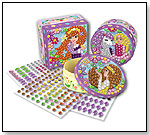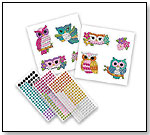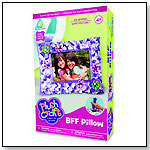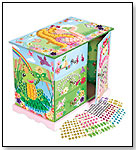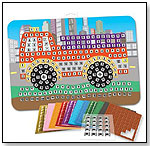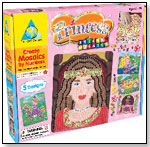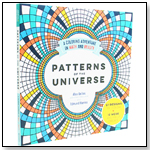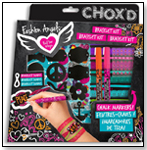|
|
Q & A With Steven Kay, President of The Orb Factory Artistic Drive and Business Savvy Made Kay's Company a Success
How did the company get to where it is today? Below, Kay tells TDmonthly Magazine how he got started ― from making his first 10,000 products with his own two hands and finally getting the company's first bank loan, to making millions of dollars in sales each year and moving production to China ― all the while staying true to the company's main goal of producing high-quality products that inspire creativity and confidence in kids. You can see some of The Orb Factory's products below the interview. 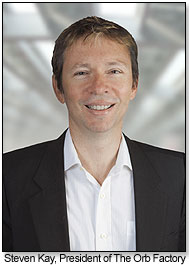 Q. What career path did you originally envision for yourself? Did you ever anticipate working with children’s products? A. I originally imagined I would be a sculptor. I studied Fine Arts at University, and worked as a Ceramic Artist for a few years. I had a vision of a large room with every imaginable tool in it. I wanted to be able to make beautiful objects that I could share with other people who would enjoy them. I never anticipated working with children's products. But when I started designing toys as an adult, I realized I was actually making my way back to something I had enjoyed doing as a child. Q. Where did you grow up? A. Moncton, New Brunswick Q. Where did you study? A. I studied Fine Art at Mount Allison University in Sackville, New Brunswick, and Nova Scotia College of Art and Design in Halifax, Nova Scotia. Inspiration for Starting the Company Q. How did you come up with the idea for your first product? A. In the late 80's, I was dating a girl who lived 1000 miles away. We were both students with no money. I was looking for a way we could earn cash to afford plane tickets to see each other once a month. I was good with my hands, and started looking for something I could make without any specialized tools or equipment and sell for under $20. My first product was the Orb. It was a re-design of an old toy that had been around for thousands of years. This theme of taking something old and making it new again with modern materials is the same process by which I developed Sticky Mosaics, and other newer products. Q. What steps did you need to take to go from the original spark of an idea to actual production? How long did it take? A. I knew nothing about toy design when I started. In the beginning my prototypes and manufacturing techniques were very basic. I wrapped wire around broom handles, and bent smaller loops in it with wire. Q. How much money did you need to create the first prototype and come up with a business plan? A. I started with $50, some wire, beads, and a pair of pliers. The first 10,000 or so Orbs were made by me, with my own hands. I made enough money to start hiring people on piecework. I made my first Orb in 1988 but didn't start The Orb Factory until 1991. It took another 3 years to reach real volume manufacturing. The biggest obstacle was cash flow. Those early years developed without loans- the bank looked at what I was doing as a hobby, not a business. I put together my first business plan very early on. My goal was to reach $100,000 in sales by the end of the second year of operation, which seemed unbelievably ambitious at a time when my only markets were craft shows. Q. How did you raise it, and how long did it take to raise it? A. I was not able to raise any money from outside. My only option was to invest all profits from sales back into the company. Creating Great Products — While Keeping Costs Low Q. What aspect of the toy industry most surprised you when you first started? A. I was surprised by how quickly my products were "copied" by other larger companies. For a small company starting out with a great idea, this was a saddening realization. I couldn't understand why the larger companies were so uncreative that they had to copy. I decided that if I ever became a larger company, this is something I would never do. Q. What do you consider to be your greatest accomplishment in the toy industry? Why? A. We consider it a great accomplishment to have been nominated for the Toy of the Year Award. There has been a lot of discussion lately about the way toys influence kids, and impact on what they do as adults. We try to design products that give kids a sense of accomplishment. Hopefully this translates into a positive impact on a generation of future adults, and in turn on the planet. I have had storeowners approach me at trade shows to thank me personally for supplying their businesses with successful products. Knowing we are providing products that help toy storeowners add real dollars to their bottom line is another accomplishment we are proud of. Q. What were the top two or three most significant obstacles you had to overcome to achieve success, and how did you do it? A. The business grew very quickly in the beginning, and hung between 1 and 2 million in annual sales for several years. We realized it was impossible to operate on low margins that came along with trying to manufacture in North America. Everything changed when we moved production to China. Making this transition was a huge challenge not only in terms of cash flow and business relationships, but also philosophically, in terms of giving up on keeping manufacturing at home. Another significant challenge we faced was finding a bank that believed in what we were trying to build. We live in a small coastal city where bankers are more used to financing the purchase of fishing boats and real estate. It took us many years to find a bank that understood the types of things we wanted to do, and was willing to support us. 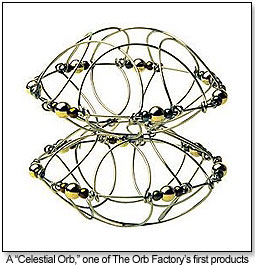 Q. What is the most disappointing thing that you have to live with as a business owner? A. When people say something is impossible, are afraid to face a challenge, become indifferent, stop caring, or stop trying to be the best they can be. Q. If you had to start over, what would you do differently? A. Network, and ask for help more often. There are so many great people willing to share their experiences and provide help to small companies. Q. What hardships did you have to overcome during your formative years and how did they help you persevere as a business owner? A. We didn't have much money growing up. Toys were scarce, and there was one channel on TV. We lived in a very rural environment. I was an only child, and my few friends lived several miles down the road. When you don't have a lot, you learn to work with what you have. My great grandfather taught me how to make a toy out of a button and a string, miniature rockets out of tinfoil and matches, and dart guns out of rubber bands, pins and cardboard. These experiences have helped me to understand as a business owner that everything we need is right here, right now in front of us- we only need to understand how to put the pieces together. Insights and Advice Q. What makes your products better than the competition? A. I believe our products are good, but good product alone is not good enough these days. We strive to product excellent products, of excellent quality, at fair prices, delivered with industry leading customer service. It’s that combined approach from a team-oriented company that makes us special. Q. How do you hope your product/s will affect children's lives? A. I remember how exciting it was to have success with craft projects as a child. Success made me want to do more crafts, and make every project more beautiful than the last. I also remember how frustrating it was when things didn't work the way they should. I want every product we make to give children a strong sense of success. For this to happen, our craft kits need to be well designed. Our designers need to predict and address every issue the child may have. That feeling of "I can do it!" will transfer over to other parts of a child's life, creating confidence, and a willingness to try new things. Q. Where do you think the industry is headed? A. Short Term I think the specialty toy industry retailers and producers will not only survive but flourish over the coming years despite the challenges. Toy producers need to become better partners. More sensitive to the needs of stores, providing free play day materials, product samples, interesting signage and point of purchase displays, and information that helps the sales people on the floor to inform consumers on the features and benefits of each product. Stores need to become more fun, entertaining and informative, helping the consumer to find the right toy for the child's needs. It’s all about the face-to-face relationship. Long Term The specialty toy industry will continue to prosper because of the many talented people that are drawn into our industry. The dedicated specialty retailers, reps and manufacturers will continue to build a strong partnership. They are committed to the mission of providing high quality toys and art & craft activities that deliver excellent play value. This combination of talent and focus assures that our industry will continue to meet the needs of children, parents and caregivers, thus creating a sustaining business model. Q. What do you think are the 3 most essential steps one needs to take to launch a toy company? 1. Play! And play with kids. It will help you to reconnect with what it was like to be a child yourself, so you can remember what "cool" and "fun" means. 2. Find a product that you can be passionate about. This is where you'll find your energy when things are tough. 3. Be financially conservative- never spend yourself into a corner, and never take your eyes off your margins. Check out a selection of The Orb Factory's products, below.
 Writer's Bio: Justina Huddleston graduated Magna Cum Laude from Emerson College with a BA in Writing, Literature, and Publishing in 2009. After graduating she was the on-site director of the Boston Children's Museum gift store for a year, selling educational, developmental, and creative activity toys that tied in with the museum's exhibits. Justina also interned at children's book publisher Candlewick Press before moving from Boston to Los Angeles, where she is now Editorial Director of TDmonthly Magazine. Read more articles by this author Writer's Bio: Justina Huddleston graduated Magna Cum Laude from Emerson College with a BA in Writing, Literature, and Publishing in 2009. After graduating she was the on-site director of the Boston Children's Museum gift store for a year, selling educational, developmental, and creative activity toys that tied in with the museum's exhibits. Justina also interned at children's book publisher Candlewick Press before moving from Boston to Los Angeles, where she is now Editorial Director of TDmonthly Magazine. Read more articles by this author |
| |||||||||||||||||||||||||||||||||||||||||||||||||||||||||||||||
Disclaimer Privacy Policy Career Opportunities
Use of this site constitutes acceptance of our Terms of Use.
© Copyright 2025 PlayZak®, a division of ToyDirectory.com®, Inc.

